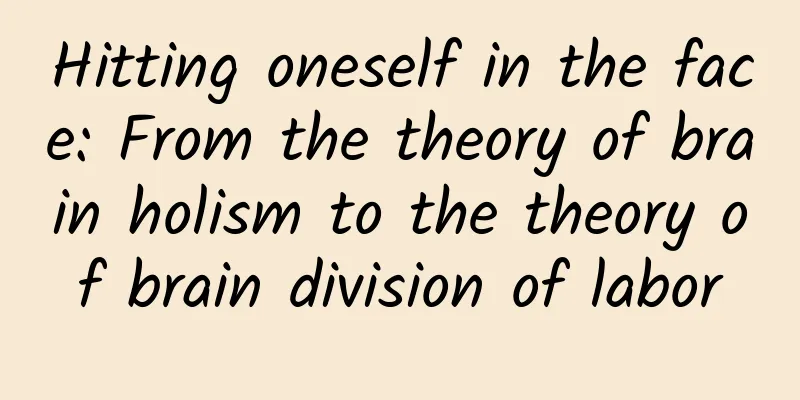Hitting oneself in the face: From the theory of brain holism to the theory of brain division of labor

|
Produced by: Science Popularization China Produced by: Xiao Yi Producer: Computer Network Information Center, Chinese Academy of Sciences Have you ever wondered how your brain understands what others mean and how it directs your voice when you communicate with others? Does the brain work as a whole or does it have different areas that perform different functions? Image source: veer gallery This question can be traced back to the observations of two famous doctors in the 19th century on patients with language disorders. At that time, French neurophysiologist Pierre Flourens believed that the brain's functions were unified. He destroyed part of an animal's brain by resection and then recorded the effects of the injury on its behavior. He observed that even if an animal had part of its brain removed, it sometimes still had the function corresponding to the removed brain area, that is, the originally lost function would be restored. From this he believed that the functions of the brain were unified, or at least some parts of the brain could take on the capabilities of other parts. In 1861, the French Anthropological Society organized a series of academic seminars in Paris to explore the location of language in the brain. A surgeon named Paul Broca also believed in Fluron's view that the brain operated as a whole and that any attempt to locate language function would fail. Unexpectedly, God played a joke on Broca. Shortly after he made the above statement, a patient named Victor Leborgne was transferred from Bicêtre Hospital to his hospital. This miraculous patient had lost his language function for 21 years, but he could understand what others said to him and could use simple gestures to answer questions, but he could only make a sound similar to "Tan". After he was transferred to Broca's hospital, Broca conducted a comprehensive examination of the patient and found that there was nothing wrong with the patient's vocal organs. Since he could only make the sound "Tan", people in the hospital called the patient "Tan". Soon after, Tan's right arm and right leg began to paralyze, and Tan died on April 17 of the same year. Image source: veer gallery After Tan's death, Broca dissected his brain and found an egg-sized cavity filled with fluid behind the second and third anterior gyri of his left frontal lobe, which was obviously different from a normal person's brain, while other areas of the brain were not significantly different from those of a normal person. Therefore, it was speculated that Tan's symptoms before his death might be related to the lesions in this area. In other words, the human brain may really have functional areas. In the following years, Broca recorded 25 patients like "Tan" who all had damage to the frontal lobe of the left hemisphere of the brain. In 1865, Broca pointed out in his report that language loss was related to damage to the third anterior gyrus of the left frontal lobe, provided that there was no lesion in the vocal organs and no damage to intelligence. Since none of the patients showed signs of right frontal lobe damage, that is to say, the language center is unique to the left frontal lobe of the brain. Broca's discovery fundamentally changed the debate on the location of brain function. In order to commemorate Broca's contribution to brain science research, people defined the language area he discovered as Broca's area. This also overturned Broca's early belief that the brain is a whole. Unexpectedly, it was Broca himself who slapped himself in the face! Aphasia caused by damage to Broca's area is called "expressive aphasia" or "motor aphasia", which does not prevent them from understanding what the speaker means. It's just that the patient cannot use fluent sentences, but can only express in short and interrupted, telegraphic speech, and they also know that their expression is not fluent. Broca's discovery provided a concrete and clinically proven basis for the theory of brain function localization, becoming a milestone in the history of science. It also laid a theoretical foundation for subsequent research on different brain regions and their corresponding functional characteristics. Image source: mercercognitivepsychology More than 10 years later, a German scientist named Carl Wernicke discovered another type of aphasia, in which patients can speak with normal voice and intonation, but the words they say do not make sense. The brain damage that causes this type of aphasia is also on the left side of the brain, closer to the back of the brain than Broca's area, in the upper part of the temporal lobe. Therefore, people named this brain area after the first discoverer - Wernicke's area. This inability to speak complete and meaningful words and to understand what others say is also called "sensory aphasia." Later, American psychobiologist Roger Wolcott Sperry confirmed the "left-right division of labor theory" of brain asymmetry through the "split-brain" experiment. This study showed that in addition to language functions, the left hemisphere of the brain is also responsible for reading, writing, digital calculations and logical reasoning, while the right hemisphere mainly processes information such as spatial relationships, emotions and art. Image source: Veer To this day, scientists are still exploring the physiological and brain science foundations behind human behavior. Is it the sophisticated and mysterious brain that gives humans complex and changeable behaviors, or is it the complex and changeable behaviors that continue to shape our sophisticated brains throughout history? The mysterious and complex brain attracts researchers from all over the world to explore it. I hope you will participate in future research on the brain. References: Gazzaniga, & Michael, S. . (1967). The split brain in man. Scientific American, 217(2), 24-29. Hegenhan, J., & Guo, B. (2004). Introduction to the History of Psychology. East China Normal University Press. Hoselsall, Guo Benyu, & Wei Hongbo et al. (2015). Psychologists' Stories. The Commercial Press. Bonior, A. (2016). Psychology: Essential thinkers, classic theories, and how they inform your world. Zephyros Press. |
<<: Why are green apples so sour (even when ripe, they have a high content of organic acids)
>>: Delta is here, can domestic vaccines still provide effective protection? Industry insiders: Yes!
Recommend
How to soften the cervix
For pregnant women in the late stages of pregnanc...
What is bilateral lobular hyperplasia?
Many women are very familiar with bilateral lobul...
The outpatient clinic was full after the rainstorm. It turns out that this is the reason! You should know these things about thunderstorm asthma
The number of patients with cough and asthma has ...
Can I lose weight after having a miscarriage?
Some women always get pregnant accidentally, and ...
Sensor Tower: Top 10 global popular mobile app revenues in September 2022
Sensor Tower Store Intelligence data shows that i...
Can female genital ulcer heal itself?
When a woman gets genital warts, she must tell he...
Pain in buttocks and coccyx during menstruation
Menstruation is something every woman will experi...
Black blood in menstruation
With the continuous improvement of life, we are a...
What foods should I avoid when suffering from sciatica? How can I relieve sciatica?
Sciatica is a type of pain that affects normal si...
Can pregnant women eat inulin?
As we all know, inulin is highly nutritious and h...
Breast discharge during early pregnancy
It is common to have breast secretions in the ear...
What to do if you have stomach discomfort during pregnancy
After pregnancy, women often experience a lot of ...
Symptoms of a boy at 38 weeks of pregnancy
At 38 weeks of pregnancy, it is in the late stage...
Can I eat black beans after abortion?
You should know that abortion is not an easy thin...









